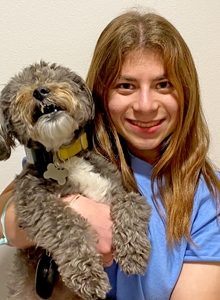This article came out of discussions between the authors about guidelines for a more neurodiversity-affirming practice for autism. The training that is discussed in this article was developed by the first author (Rebecca Rosenzweig).
Authors’ note: As an autistic person working in a program that offers ABA, my goal is to change some common practices to better reflect evolving research. ABA practices are controversial in the autistic community. However, ABA is currently the most common approach experienced by autistic people in the United States. My goal is to help autistic people currently receiving ABA services, or other related services, to be better understood and supported. It is not the purpose of this article to debate whether ABA should receive support by the progressive autistic community. Many professionals “don’t know what they don’t know.” We need to help service providers to be informed by those who know best, autistic people.
ABA programming is often not aligned with what the autistic self-advocate community believes is helpful for autistic people. ABA programs can be counter-productive and can cause harm in the long run when they are not informed by research (Kupferstein, 2018) and reports of autistic individuals (Price, 2022). Commonly, ABA goals intend to change behavior to reflect neurotypical norms and standards. I believe we must change our focus from “How can this child blend in seamlessly with society?” to “What tools does this child need to thrive in a society with social and behavioral expectations and sensory environments that were not created for them?” Autism is a lifelong condition. We must find ways to live in harmony with the neurotypical world despite our neurological differences.
Examples of common practices of concern include eye contact training and eliminating stimming and scripting. The justification is that such behavior makes a person look different. However, the problem with training an autistic person to mimic neurotypical ways is that often it is not their authentic way of responding due to their neurological differences. Often, it sends the message that the child is behaving badly, and the “problem” must be fixed. Eventually, the need to mask, that is, to suppress natural reactions and autistic characteristics, gets so strong that we lose who we are in the process (Price, 2022). By changing practices to be more respectful of differences between the autistic and neurotypical experience, we can improve the lives of autistic people.
While I worked with autistic clients and staff, I reflected on what did not feel right in observing ABA practices. Then, I created an autism sensitivity and awareness training for my coworkers and supervisors, based on my personal experiences, those of autistic friends, and literature written by autistic authors.
This training focuses on ways to make practices I observed to be more respectful and more neurodiversity-affirming. I focus on critical areas for change, the most important being for staff to understand the autistic experience. I found that staff, even with years of experience, were not aware of many of these issues. They were open to learning.
Sensory Processing Differences, Dysregulation, and Anxiety
Most autistic people have sensory processing differences. We have eight sensory systems: visual, auditory, olfactory, gustatory, tactile, vestibular, proprioception, and interoception. Any type of sensory input can be magnified (e.g., the lights are too bright), minimized (e.g., oblivious to a skinned knee) or cross-modal, also known as synesthesia (e.g., the sounds are too colorful). This can feel confusing, overwhelming, painful, or pleasurable.
Sensory dysregulation can be a barrier to essential skills, such as paying attention, learning, emotional regulation, and behaving “appropriately.” For example, if it is too loud, it is hard to focus. If you cannot focus, it is hard to learn. If you cannot learn, you feel anxious and frustrated. If you feel frustrated, you act frustrated and become dysregulated.
It can be difficult to explain sensory challenges, due to the specific nature of the sensory challenge(s), challenges in expressive language and communication, and limitations in body awareness. Until I was a young adult, I assumed everyone processed sensory input in the same way. It was not until I read about sensory processing challenges that I had the words to articulate what I was feeling, and therefore get my needs met.
Many autistic people engage in self-stimulatory behavior to self-regulate. Stimming involves repetitive movements or vocalizations that increase sensory input and that many autistic people do to self-regulate. Some people have specific stims that communicate different states and serve different purposes. For example, rocking could be used to lessen anxiety due to sensory dysregulation or sadness, while hand flapping could be tied to excitement or anger. Observing stims can help staff to figure out how someone may feel. Unless a stim is harmful, staff should let it be. If it does not appear to help a person, other ways to regulate can be modeled or taught.
Sensory processing challenges can look like behavioral issues. For example, if a child is having a meltdown while waiting for his turn on the swing, perhaps he has a sensitive visual and/or vestibular system, and watching the swing go back and forth is making him feel extremely dysregulated. It is necessary to be informed about all eight of the sensory processing systems and how dysregulation looks and feels. What may look like behavioral challenges can be understood more accurately, and autistic people can be better supported (Biel and Penske, 2018)
Staff Language and Communication
Word choices matter. They influence actions, expectations, clients’ feelings, and how society views autism. For example, functioning labels should be eliminated (Prizant, 2012). “Low functioning” is often inaccurate, underestimates an individual’s abilities, and dwindles parents’ hope for their child. “High functioning” may minimize the challenges and support needs. In either case, the autistic person is misunderstood. Instead, refer objectively to specific strengths, challenges, and types of support needs.
Additionally, it is important to be mindful of ambiguity in language. Most autistic people interpret words literally, often resulting in misunderstanding. For example, if you say, “Grab a seat.” We may think, “You want me to pick up a chair? Why?” Instead, try “Sit on your chair.” Saying something like “Sit still while you eat,” can immediately cause panic. In our mind, we are not allowed to move at all.
Understanding Autistic Communication
Many autistic people communicate through echolalia. This is often a strategy to communicate intentionally and meaningfully. It is important to “play detective” and decipher patterns and purposes for echoing until the client is understood (Prizant, 2022). Additionally, expressive language does not equal receptive language. Always assume comprehension, regardless of the person’s language and communication complexity. Many people who are non-speaking or who communicate minimally through speech often understand much more than it may appear. It may be necessary to adjust language complexity, but comprehension abilities should not be underestimated.
Communicative Gaze (Eye Contact)
For many autistic people, it is challenging to look at people’s faces when they are speaking. It can be difficult to listen, respond, and self-regulate while looking at others. Studies suggest that eye contact programs are not helpful and often increase anxiety (Hadjikhani et al., 2017). Instead, practice alternative ways with clients to show that they are attending, including vocalizing (e.g., uh huh), or brief glances.
Conclusion
Our knowledge about autism is constantly evolving. Misinformation and old myths are being put to rest, as autistic people share new insights based on research and their life stories. In order to best support autistic people it is necessary to adapt current practices and abandon ineffective and harmful practices, to fit what we now know about autism. I have addressed only a few aspects of common practices of concern. It is essential that we continue to monitor research and listen to autistic voices and to be vigilant about further changes that may be needed.
If you are interested in the training, contact Rebecca Rosenzweig at Rebecca.rosenzweig@gmail.com. Dr. Barry M. Prizant is a research and clinical scholar on the topic of ASD. He is also a faculty member at Brown University.
References
Biel, L, & Penske, N. (2018). Raising a sensory smart child. Updated and Revised Edition, New York: Penguin Books.
Hadjikhani, N., Åsberg Johnels, J., Zürcher, N.R. et al. (2017). Look me in the eyes: constraining gaze in the eye-region provokes abnormally high subcortical activation in autism. Sci Rep 7, 3163. https://doi.org/10.1038/s41598-017-03378-5
Kupferstein, H. (2018) Evidence of increased PTSD symptoms in autistics exposed to applied behavior analysis. Advances in Autism Research, http://dx.doi.org/10.1108/AIA-08-2017-0016
Price, Devon (2022). Unmasking autism: Discovering the new faces of neurodiversity. New York: Harmony Books.
Prizant, B.M. (2012). Low- and High- functioning autism: A false (harmful?) dichotomy. Autism Spectrum Quarterly, Winter, 31-33
Prizant, B.M. (2022) Uniquely human: A different way of seeing autism. Updated and expanded edition. New York: Simon & Schuster.







